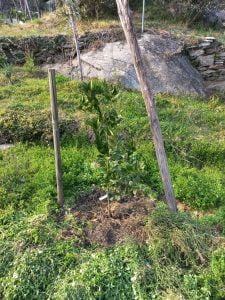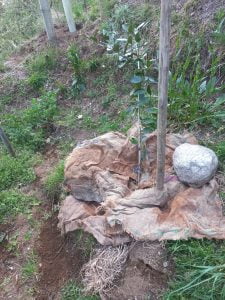Watering
Tap water is generally suitable for a wide range of uses.
ê
even if it contains additives such as chlorine. On the other hand, if the water is very hard in your area, it is not very suitable for citrus fruits. In this case it is more beneficial to use rainwater. Collect it, for example, by placing a can under a gutter.
Mature citrus trees, planted in the ground, only need to be watered if there's a shortage of rain.
Water deficits are becoming more frequent and intense in Europe, even in regions where this did not happen in the past, including Switzerland. However, if the rainfall is regular enough, additional warering is not required and can even be harmful in case of excess.
In case of lack of rain, or even drought, all types of citrus fruits do not tolerate roots drying and this in all seasons, not only in summer. Citrus trees are evergreens and never go completely dormant.
Therefore, monitoring the moisture level of the soil is necessary all year round, not just in the spring and summer.
The sensitivity of citrus to drying out is due to its root structure.
They develop a large root that plunges straight down. But the vast majority of roots grow horizontally, in all directions around the trunk, to a depth of no more than 40cm.
This superficial zone is the one to keep under observation to avoid any risk.
For regular monitoring we all have an infallible instrument: the finger.
Plunge your index finger a few inches into the ground, in line with the branches, not near the trunk. Scrape a little if necessary to get in deep.
You can smell a little moisture: no need to water.
It's all dry: you need to give it something to drink.
If you're in any doubt, you're better off watering.
If your finger doesn't go into the soil even when scraping, it is too compacted. See the following paragraphs on mulching.
The tree absorbs nutrients and water mainly through its thinner roots. They are mostly concentrated outside the growth area. For a mature tree, you should water in a circle around the tree, in line with the branches. For a young tree or one that has just been planted, you can just fill the cup at the foot of the tree with water.
The quantity of water to bring for each watering will be approximately 10L. For an adult tree that is already large or in case of heat wave or drought, do not hesitate to double the dose.
There is no regular watering schedule, but rather a monitoring schedule: every two to three days during seasons when there is little or no rainfall.
Hint: In a hot, dry summer, you may find that the soil has dried out every time you check. Then it will be necessary to water up to twice a week.
Avoiding rapid drying of the soil will allow you to space out watering and ensure a more stable environment for the tree. The soil must be protected from direct sunlight.
The most effective method is plant mulching. Around the tree, lay a 20 cm to 30 cm thick layer of cut vegetation, mulch (chopped grass), hay, dry leaves, ferns, vegetable garden scraps, cereal straw, pruned roots and branch shavings. No industrial sawdust and especially no pine bark which can change the Ph (acidity level) at the foot of the tree. The mulch circle around the tree will be about 50cm in radius, it should fill the cup (see Planting) and extend well beyond it. In the center of the circle, leave a little free space around the trunk, so that the graft suture is exposed to the air.
Do not pile the mulch directly against the wood.
To easily avoid this, you can place removable, ventilated protections around the trunk. However, avoid rigid tubes without holes around the trunk, as they can harbour parasites and restrict growth.
This layer needs to be maintained, as it will settle and assimilate into the soil very slowly.
Mulching is never permanent. It disappears, fades and discreetly feeds your tree. It must be renewed, adding layers, so that the protection against the sun is continuous.


In addition to providing a more stable moisture level for the tree, a thick mulch is also a protection for the soil fauna. In the earth, under this shelter, many animals and organisms, from the tiny to the invisible, will take refuge and reproduce: earthworms, insects, mites and bacteria. They will dig, aerate, decompact and enrich the soil by transforming the plants and fertilizer into nutrients that can be assimilated by the tree. Its root network will be healthier, stronger and more dynamic. In case of compacted soil, mulching is therefore essential.
Mulching also has advantages in winter. By acting as a thermal damper, it will establish a nano-climate at the base of the tree, adding inertia and slowing down the penetration of cold and excessive heat.
Once the tree has grown well, it can become taxing to maintain a permanent mulch. The wider canopy will provide shade around the trunk. This is a first protection.
Don't hesitate to sow a short green manure to better shelter the soil. Look for local annuals that will grow best in your area, clover being among the most common and adaptable. After three years, the citrus fruit is young but already consolidated. Its roots go deep and far, they entered in symbiosis with the mycelium. Mulching is still recommended as it is always beneficial. But it is less critical and can be lightened or even phased out. The adult tree will also begin to make its own humus by renewing its foliage throughout the seasons.
During the first three years after planting, the tree has not yet colonized with its roots all the space that it will occupy as an adult, neither in depth nor in width. It is much more vulnerable than an adult to root desiccation.
Keep a close eye on immature trees, for their first summer in the ground of course, but also in case of winter drought, without rain or snow.
Thick mulching is even more important for vigorous initial growth, to be maintained assiduously at least until the third year. Remove any wild, tall grass that may be growing even through the mulch. They compete with the very young tree for soil nutrients.
Never use plastic sails, or worse, PVC tarps, to replace plant mulch. This would have the opposite effect by causing thermal jumps, harmful to the tree and the native microfauna.
If you can't guarantee a plant mulch for your young trees, get some canvas or burlap bags and lay them all around, without pressing them against the trunk, possibly in a double layer. They can provide good sun protection and partially slow the growth of competing wild grasses. Block them with stones or the wind will move them.
Today there are also products studied for an easy and natural mulching of fruit trees, in pre-cut biodegradable pieces.
These products are unfortunately difficult to find in retail stores.


The general principles described above also apply to potted plants. Keep the soil moist but not soggy. The mulching is replaced by coconut discs, which are easily available in different diameters. Remove the disc before watering to ensure even distribution over the entire surface.
The only specific point is to absolutelyavoid sub-vases. Permanent standing water is not beneficial to the roots, which can become susceptible to phytophthora and be damaged.
We do not recommend to let the trees available on this website grow in pots, because they will never reach their natural size and productivity. Unless you use larger and larger Air-Pots, up to a size of 100 to 400 liters depending on the variety, which guarantee a healthy and sustained growth.


